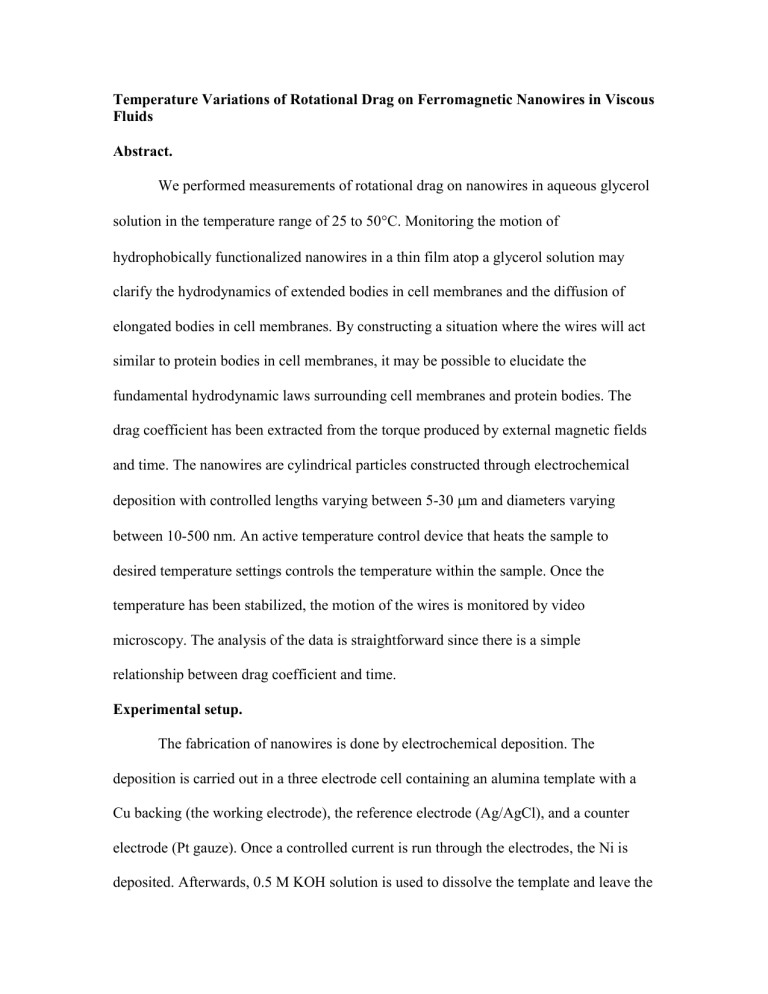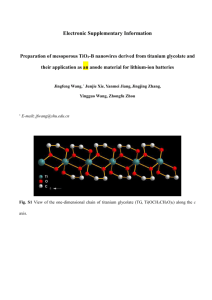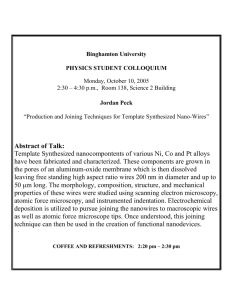Changes in Viscosity of Nickel Nanowires in Thin Silicone Films

Temperature Variations of Rotational Drag on Ferromagnetic Nanowires in Viscous
Fluids
Abstract.
We performed measurements of rotational drag on nanowires in aqueous glycerol solution in the temperature range of 25 to 50
C. Monitoring the motion of hydrophobically functionalized nanowires in a thin film atop a glycerol solution may clarify the hydrodynamics of extended bodies in cell membranes and the diffusion of elongated bodies in cell membranes. By constructing a situation where the wires will act similar to protein bodies in cell membranes, it may be possible to elucidate the fundamental hydrodynamic laws surrounding cell membranes and protein bodies. The drag coefficient has been extracted from the torque produced by external magnetic fields and time. The nanowires are cylindrical particles constructed through electrochemical deposition with controlled lengths varying between 5-30
m and diameters varying between 10-500 nm. An active temperature control device that heats the sample to desired temperature settings controls the temperature within the sample. Once the temperature has been stabilized, the motion of the wires is monitored by video microscopy. The analysis of the data is straightforward since there is a simple relationship between drag coefficient and time.
Experimental setup.
The fabrication of nanowires is done by electrochemical deposition. The deposition is carried out in a three electrode cell containing an alumina template with a
Cu backing (the working electrode), the reference electrode (Ag/AgCl), and a counter electrode (Pt gauze). Once a controlled current is run through the electrodes, the Ni is deposited. Afterwards, 0.5 M KOH solution is used to dissolve the template and leave the
free floating nanowires in solution. The mixture is then centrifuged and the KOH is then removed and replaced with pluronic solution. The pluronic creates a hydrophobic outer layer for the nanowires, allowing them to repeal the viscous fluid they will sit in. The lengths of the wires varied between 5-30
m and the diameters varied from 10 to 500 nm.
The magnetic moment of the nanowires was 400 emu/cc
3
.
The nanowires are mixed in with the viscous fluid and dispersed by sonication.
Sonication will also help break up clumps of wires but may break some of the wires as well. Different concentrations of aqueous glycerol solution have been used in order to find the optimum solution to perform the experiments. We specifically tried 75% glycerol and 25% water solution as well as 90% glycerol and 10% water solution. Precautions must be taken since glycerol absorbs water readily; nitrogen was used to prevent absorption. The aqueous glycerol solutions were placed in petri dishes and covered with parafilm to prevent any moisture from getting into the solution. Then, a magnet was brought to the top of the petri dish holding the nanowires since some of the nanowires may have sunk to the bottom. The magnet will bring the nanowires to the surface of the solution, which is crucial for accurate data collection. The wires stay at the top because the hydrophobic layer prevents the wires from sinking again. Surface tension on the aqueous glycerol solution also helps the wires stay on top.
Diagrams are provided to show the actual layout of the setup. Magnetic field is generated by two sets of magnets. There is a constant field set up in the vertical direction
(fig. 1 A). Helmhotz coils provide variable magnetic field which is controlled by Kepco power supplies in the horizontal direction (fig. 1 B). A program is run in LabView that precisely instructs how much current is passed to the Helmhotz coils with set time
intervals. Live Cell controls the temperature within the petri dishes by blowing hot air to reach a specified temperature (fig. 1 C). A plexiglass box is set up to make sure the heat provided by Live Cell is contained (fig. 2 K). It takes about 30 to 40 minutes for the petri dish to heat up and stabilize. There is a temperature probe (fig. 1 E) from the manufacturer Live Cell which records the current and desired temperature for petri dish
#2 (fig. 1 F) through petri dish #1 (fig. 1 D) contained with the same fluid on the left side.
To make sure petri dish #2 (fig. 1 F) reaches the desired temperature and stabilizes, another probe is inserted into petri dish #3 (fig. 1 G) on the right side of petri dish #2 (fig.
1 F). Once the temperature has been stabilized, the angular motion of the wires is tracked via video microscopy. Using a Nikon Eclipse TE 2000-E microscope magnified at 10x
(fig. 2 J), a consumer Nikon camera (fig. 1 and 2 I) takes pictures of the wire at 30 frames per second onto iMovie software, serving as the source of data acquisition. The data itself takes about 3 to 4 minutes to collect while the wire must be monitored so that it does not move off the screen.
Once data has been attained, data analysis is done through Igor software where a program for angular particle tracking will monitor the nanowires' response to set time interval magnetic fields and the information will be converted to determine the rotational drag as a function of angle change and time. The film of the single wire will be converted to black and white. A threshold and an area of interest will be determined to separate the angle change of the wire with movement from other substances in the fluid. By tracking a single wire, it is possible to make more accurate and precise conclusions about viscosity changes. Vibrations and translational displacements have only a weak effect on the data and results.
Introduction.
In biophysics, low Reynold's numbers are especially interesting for the purposes of nanotechnology development. The Reynold's number corresponds to the ratio of inertial forces to viscous forces in a specific substance (). In the nanoworld, laminar flow, a smooth and constant fluid motion, is dominant (diagram?). In studying laminar flow, this project is mainly concerned the motion of substances in cellular membranes. The movement of protein bodies through a continuum fluid environment is especially important in many cellular processes (). This particular study focuses on two-dimensional angular motion of amphiphilic nanowires in a thin film on a surrounding bulk fluid. The movement of the nanowire is dependent on a force determined by a viscous friction coefficient
0
. A major problem arises such that the drag coefficient of the fluid is not linear to either size or viscosity (). In the situation we have created, it has been established that the wires quickly reach terminal velocity and for data collection and analysis, angular acceleration is equal to zero. There, angular torque is no longer a measure of moment of inertia multiplied by the angular acceleration; rather, it is the product of drag coefficient and angular velocity.
A two dimensional situation is simulated when a nanowire is place in a viscous oil on top of an immiscible viscous solvent. The two dimensional analysis is different from the three dimensional analysis as a function of length. In particular, there are power laws regarding different dimensions. It is possible to examine the motion of the wire and present a general overview of the movement of objects like protein bodies in cell membranes (). The ferromagnetic nanowire serves as a rheological probe; a tool that can measure the viscosity of the fluid. Rheological tools locally measure the mechanical
properties of substances (). The setup includes providing the wires with a constant magnetic field, allowing the wires to all orient in one direction. Using Helmhotz coils, a temporary magnetic field can be created so that the nanowire will rotate at the surface of the fluid.
This experiment will measure how much the viscosity of the fluid depends upon temperature and how quickly viscosity changes as temperature is increased. However, it is known that the length of the wire also effects how quickly the wire will rotate in the fluid. The larger the length of the wire, the more likely the wire will rotate slower, given the larger volume to cover. To compensate for that problem, we will monitor a single wire as it moves through the bulk fluid and thin film. A single wire will prevent the problem of having wires of different length interfering with data results.
Results.








